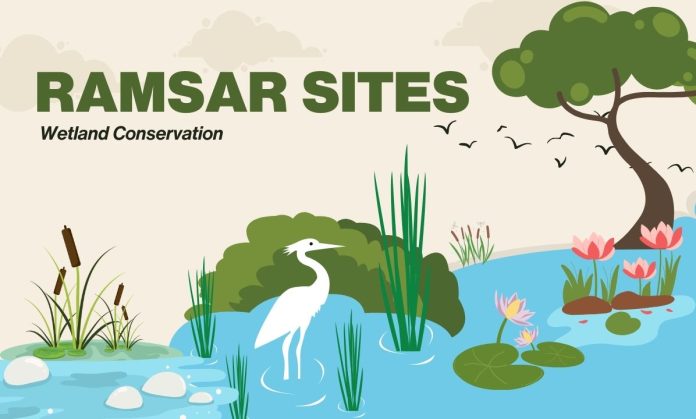A wetland is a place where the land is covered by water. Marshes, ponds, the edge of a lake/ocean, the delta at the mouth of a river, low-lying areas that frequently flood — all of these are wetlands. Wetlands of international importance are also known as Ramsar sites.
Ramsar is a city in Iran. In 1971, an international treaty for the conservation and sustainable use of wetlands was signed at Ramsar. The Convention’s mission is “the conservation and wise use of all wetlands through local and national actions and international cooperation, as a contribution towards achieving sustainable development throughout the world”.
Defined by the Ramsar Convention as areas saturated with water, wetlands encompass diverse landscapes, including mangroves, marshes, rivers, and lakes. Despite constituting merely 6% of the Earth’s land surface, they host a staggering 40% of all plant and animal species, underscoring their ecological significance.
India’s Ramsar wetlands are spread over 11,000 sq km — around 10% of the total wetland area in the country — across 18 states. No other South Asian country has as many sites though this has much to do with India’s geographical breadth and tropical diversity.
Here is the list of Ramsar sites situated in India (as of 2023):
Criteria: One of the nine criteria must be fulfilled to be the Ramsar Site.
Criterion 1: If it contains a representative, rare, or unique example of a natural or near-natural wetland type found within the appropriate biogeographic region.
Criterion 2: If it supports vulnerable, endangered, or critically endangered species or threatened ecological communities.
Criterion 3: If it supports populations of plant and/or animal species important for maintaining the biological diversity of a particular biogeographic region.
Criterion 4: If it supports plant and/or animal species at a critical stage in their life cycles, or provides refuge during adverse conditions.
Criterion 5: If it regularly supports 20,000 or more waterbirds.
Criterion 6: If it regularly supports 1% of the individuals in a population of one species or subspecies of waterbird.
Criterion 7: If it supports a significant proportion of indigenous fish subspecies, species or families, life-history stages, species interactions and/or populations that are representative of wetland benefits and/or values and thereby contribute to global biological diversity.
Criterion 8: If it is an important source of food for fishes, spawning ground, nursery and/or migration path on which fish stocks, either within the wetland or elsewhere, depend.
Criterion 9: If it regularly supports 1% of the individuals in a population of one species or subspecies of wetland-dependent non-avian animal species.
Wetlands also serve as a great tool in combating climate change. It Act as natural carbon sinks, they sequester carbon dioxide, methane, and nitrous oxide, which thereby mitigates greenhouse gas emissions. Additionally, wetlands also mitigate the risk of disasters such as floods which safeguards the coastlines and surrounding communities.
Peatlands which is a subset of wetlands, emerge as an unrecognised hero in the fight against climate change. Despite all this, they cover only 3% of the world’s land surface, and they store twice as much carbon as forests, making them inseparable in the global efforts to address the climate crisis. Yet, in India, these carbon-rich ecosystems remain sparse and are in urgent need of conservation.
Moreover, it can be said that wetlands also hold a lot of cultural and tourism significance. From the revered Loktak Lake in Manipur to the enchanting Dal Lake in Kashmir, these aquatic landscapes are intertwined with the cultural fabric of diverse regions. They serve as pilgrimage sites and various sources of inspiration for folklore which acts like a magnet for tourism, enriching both local communities and visitors
To safeguard India’s wetlands for future generations, taking valid actions becomes imperative. Developmental policies and urban planning must always be given priority for the better preservation and sustainable management of these invaluable ecosystems. Mega urban schemes like the Smart Cities Mission and Atal Mission for Rejuvenation and Urban Transformation should not only incorporate measures to protect but also restore wetlands, which will thereby ensure resilience against climate change.
In essence, the preservation of India’s wetlands is not only becoming an environmental imperative but also a moral obligation. Thus, by recognizing these ecological, cultural, and economic significance, and by embracing measures to conserve and restore them, we can create a path towards a more sustainable and resilient future for India and the planet as a whole.





























